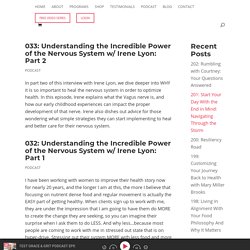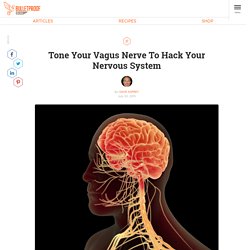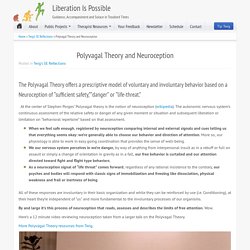

Conscious Breathing and the Vagus Nerve. Healing the Nervous System Through the Breath “I Can’t Breathe” These are the words feverishly and frantically expressed by countless individuals who have died from Covid-19.

“I Can’t Breathe” Eric Garner, George Floyd, and Elijah McClain each uttered these words being killed as a result of police brutality. Now, these words are chanted around the world as hundreds of thousands march against systemic racism. Air quality index spikes to hazardous levels across the West Coast of the United States forcing many to stay inside…it isn’t safe to breathe the air.
Mini Class - Boost the Brain Book. Vagal Breathing: Richard L Haight. The Polyvagal Map to Pelvic Health. By Maryssa Steffen, PHRC Berkeley “It doesn’t matter how much you drive around, you will never get to where you want to go if you don’t have the right map.” – Stanley Rosenberg During this unprecedented time to slow down, shelter at home, and physical distance, I have taken the opportunity to dive deeper into embodied practices.

In other words, I am interested in an integrated and embodied approach to movement, the body and consciousness. There are many paths that guide this type of work, but my recent journey has led me to Stephen Porges and his Polyvagal Theory. Proposed in 1994, it connects the dots between our internal organs and our emotional states. The vagus nerve links our autonomic nervous system to our emotions and behavior and this theory has provided a map for psychotherapists, doctors, physical therapists, and caregivers, to name a few. Image courtesy of Flickr Image courtesy of Flickr The dorsal-vagal system. Whew! Alright! References: Stephen Porges and Deb Dana, Editors. 2 Podcasts: Irene Lyon. 033: Understanding the Incredible Power of the Nervous System w/ Irene Lyon: Part 2 In part two of this interview with Irene Lyon, we dive deeper into WHY it is so important to heal the nervous system in order to optimize health.

In this episode, Irene explains what the Vagus nerve is, and how our early childhood experiences can impact the proper development of that nerve. Irene also dishes out advice for those wondering what simple strategies they can start implementing to heal and better care for their nervous system. Polyvagal Theory Explanation. Sound Therapy and the Vagus Nerve - The Sound Healer. 6 Ways to Stimulate VN to Receive Inflammation, Depression, Migraines and More. Posted on: August 20, 2015 at 10:34 pm Last updated: May 7, 2018 at 12:58 pm I read an article yesterday that has me extremely excited about the implications.

9 Fascinating Facts About the Vagus Nerve. A Polyvagal Primer. The fundamental premise of Polyvagal Theory is that human beings need safety, and our biology is fiercely devoted to keeping us out of harm’s way.

As most therapists know, the body’s rapid-response survival system is orchestrated by our autonomic nervous system (ANS). To briefly review, the ANS operates two branches: the sympathetic and the parasympathetic. The sympathetic branch mobilizes us to defend against danger via the fight-or-flight response. The somewhat less understood parasympathetic branch is typically viewed as a unitary system that helps us lower our defenses and regain a state of calm. But, as they say, it’s a bit more complicated than that. Importantly, these cues for safety and danger operate beneath our awareness. Just then, you notice one of the guests breaking away from the crowd and walking toward you. Polyvagal-Informed Therapy Notice that I said both therapist and client must become aware of their autonomic states. I Now Suspect the Vagus Nerve Is the Key to Well-being. Have you ever read something a million times only to one day, for no apparent reason, think “Wait, what is that?”
19 Ways To Stimulate Your Vagus Nerve - The Living Proof Institute. Living a life of stress and constant mental stimulation can lead us down a path of symptoms and medical conditions related to high stress.

These people are often dealing with fatigue, food sensitivities, anxiety, poor digestion, brain fog and poor sleep quality. Those who suffer with these symptoms often suffer from lower Vagal Tone, meaning that they have a lower ability of the vagus nerve to be activated and perform its functions. Tone Your Vagus Nerve to Hack Your Whole Nervous System. Every now and then, I get really excited when I see a groundbreaking new biohack.

Here’s the latest one. This amazing article shows how doctors are learning to hack your nervous system using electricity. An incredible neurosurgeon from New York, Dr. Kevin Tracey is actively hacking chronic inflammation, toxic shock, and a bunch of other nervous system issues. He and his team are doing all of it using electric currents. This isn’t some crazy guy in a garage – these are university professors who are literally running a current across one of the most important nerves in the body: the vagus nerve. So cool. Vagus Nerve Stimulation and Symptoms of Vagus Nerve Disorders. How to Heal the "Vagus Nerve" to Heal Your Mind & Body.
Tapping Into The Power of The Vagus Nerve - How Your Breath Can Change Your Relationships: The Gut-Brain Connection: Vagus Nerve — Philadelphia Integrative Medicine. How to Stimulate Your Vagus Nerve for Better Mental Health. It connects your brain to many important organs throughout the body, including the gut (intestines, stomach), heart and lungs. In fact, the word "vagus" means “wanderer” in Latin, which accurately represents how the nerve wanders all over the body and reaches various organs.
The vagus nerve is also a key part of your parasympathetic “rest and digest” nervous system. It influences your breathing, digestive function and heart rate, all of which can have a huge impact on your mental health. Polyvagal Theory Dr Stephen Porges. Polyvagal Theory and NeuroceptionPolyvagal Theory and Neuroception - Liberation Is Possible. At the center of Stephen Porges’ Polyvagal theory is the notion of neuroception (wikipedia).

The autonomic nervous system’s continuous assessment of the relative safety or danger of any given moment or situation and subsequent liberation or limitation on “behavioral repertoire” based on that assessment. When we feel safe enough, registered by neuroception comparing internal and external signals and cues telling us that everything seems okay: we’re generally able to choose our behavior and direction of attention. More so, our physiology is able to work in easy going coordination that provides the sense of well-being. We our nervous system perceives in we’re danger, by way of anything from interpersonal insult as in a rebuff or full on assault or simply a change of orientation in gravity as in a fall, our free behavior is curtailed and our attention directed toward fight and flight type behaviors.
More Polyvagal Theory resources from Twig. How Toning the Vagus Nerve Heals Pain. A few simple practices that everyone can do, could be the secret to relieving pain and inflammation.

In her article Hacking the Nervous System, Gaia Vince, science journalist and editor of New Scientist, describes how a woman suffering from debilitating rheumatoid arthritis was successfully treated with a device that stimulated the vagus nerve. No pills, no morphine, no side-effects; just stimulating a nerve. Vagus, Baby: Why You Should Care About Your Vagus Nerve.
Keeping your vagus nerve happy might be key to vibrant mind-body balance.

Learn how to keep this nerve “toned” and why it matters according to Dr. Sarah Gottfried. We could talk about avocado toast all day (and sometimes at TCM HQ we actually do), but the wellness topics that really get us going are ones like this from anti-aging expert and May Guest Editor, Dr. Sara Gottfried. How to Stimulate Your Vagus Nerve for Better Mental Health. Stimulating my vagus nerve has played a key role in the management of my mental health over the years.
What exactly is the vagus nerve? The vagus nerve is the longest nerve in your body. It connects your brain to many important organs throughout the body, including the gut (intestines, stomach), heart and lungs.